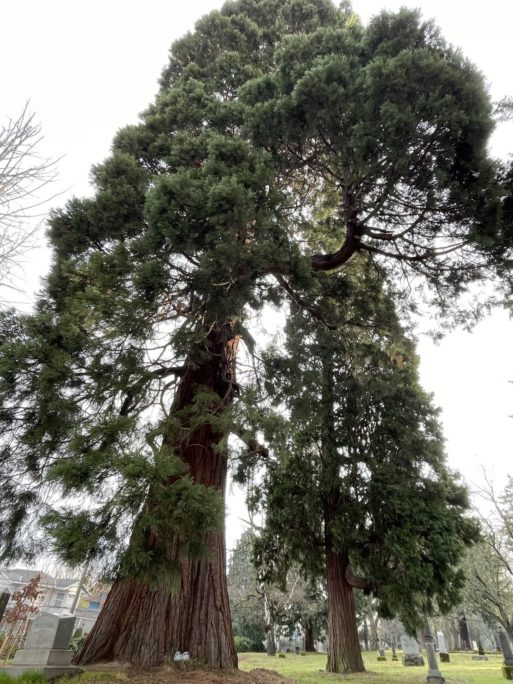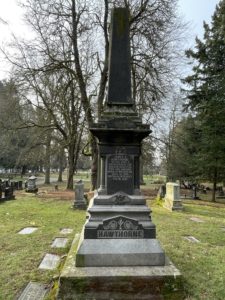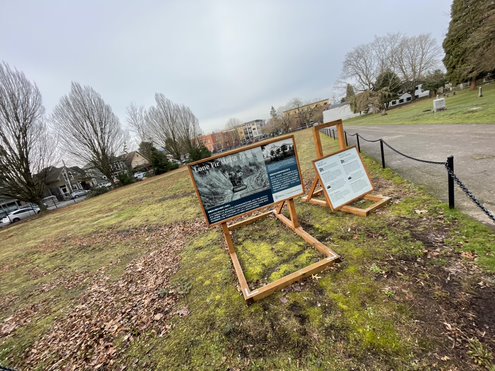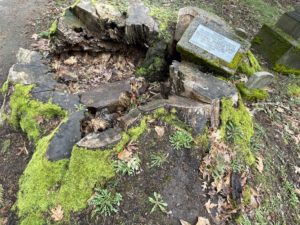
Lone Fir Cemetery is aptly named after a Douglas fir tree first planted on its grounds in the mid-1800s. It still stands tall today — nearly 170 years later.
Nestled within the confines of densely populated residential streets in downtown Portland, Oregon, Lone Fir Cemetery invites the public to explore its wide array of history, trees, and wildlife. This picturesque landscape doubles as the oldest existing cemetery in the city, as well as the second largest arboretum in the state. Unique gravestones and markers honor the area’s most notable politicians, firefighters, soldiers and notorious residents.

A monument in honor of Dr. James C. Hawthorne commemorates his well-known compassionate spirit.
Initially, Lone Fir Cemetery was a private farm where its family members were buried as early as 1846. The parcel and surrounding lands were purchased by the county about a decade later and dubbed Mount Crawford Cemetery. But in 1866, it was renamed Lone Fir Cemetery in honor of the once solitary Douglas fir tree planted in its northwest corner. Now more than 700 trees representing 67 species sprawl throughout the cemetery’s 30 lush acres. The cemetery was listed on the National Register of Historic Places in 2007.
Twenty-five thousand people are buried in Lone Fir Cemetery. Most notably, Dr. James C. Hawthorne, owner and director of the state’s first psychiatric hospital, is honored with a monument. The physician laid his patients from the Oregon Hospital for the Insane to rest on the land during the late 1800s. It is believed that as many as 200 patients are buried there, though the majority are scattered throughout the grounds in unmarked graves.
But Lone Fir Cemetery is perhaps most notoriously known for an old Chinese burial grounds located in its southwest corner: Block 14. Portland boasted a large Chinese community in the late 1800s. Immigrants had migrated to the area for gold mining and railroad work, helping to build the city of Portland.

It is estimated that more than 3,000 bodies of Chinese laborers were once buried in Block 14. Research is ongoing to determine how many bodies may still remain.
Although much of this Chinese population was buried at Lone Fir Cemetery, many bones were dug up in the early 20th century and returned to China. It is a Chinese customary practice to clean the bones, perform cultural death rituals and then bury them again near ancestors in China as a final resting place.
The county later built a monument honoring the Chinese settlers and paved atop those grounds. But community organizations including the Buckman Neighborhood Association, Friends of Lone Fir Cemetery and the Oregon Chinese Consolidated Benevolent Association informed the county that they believed the site still contained human remains. The structure was subsequently demolished in 2007 and funding was allocated for research into its history.

An historic maple tree once stood 100 feet high at the grave of General Joseph Lane , the first territorial Governor of Oregon.
There’s much more to explore of this expansive green space, including the Gothic Revival-style Macleay Mausoleum, the Soldiers Monument and Firemen’s Cemetery. There are also uniquely designed stone monuments and moss-covered grave markers scattered about the grounds commemorating local families and dignitaries. Friends of Lone Fir Cemetery hosts historical tours and events regularly.
Currently, more than 3,000 people are buried at Lone Fir Cemetery, and burials still take place here each year, adding to its designation as a local treasure rich in history and folklore.

 Lone Fir Cemetery in Portland, Oregon is an Urban Oasis
Lone Fir Cemetery in Portland, Oregon is an Urban Oasis


 “As Tears Go By” by Marianne Faithfull
“As Tears Go By” by Marianne Faithfull
 “The Sea” by John Banville
“The Sea” by John Banville
 Funeral Favors Offer Visitors a Tangible Memento
Funeral Favors Offer Visitors a Tangible Memento















